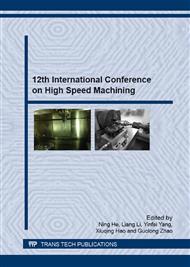p.64
p.71
p.77
p.88
p.94
p.99
p.106
p.112
p.117
Time Domain Simulation of Milling Chatter Stability
Abstract:
In this paper, time domain simulation has been carried out to study the chatter stability of milling process. Dynamic chip thickness is calculated by analyzing the kinematics of the cutter, and thus dynamic governing equation revealing the dynamic behaviors between the cutter and workpiece is established. Solving framework is constructed by using the Simulink module and S-Function of Matlab software, and dynamic deflection is achieved with the four-order Runge-Kutta algorithm. With the simulated cutting forces, a criterion for the construction of the stability lobe is suggested. At the same time, algorithm for the prediction of the surface topography involving the dynamic response of the machining system is developed.
Info:
Periodical:
Pages:
94-98
Citation:
Online since:
January 2016
Authors:
Keywords:
Price:
Сopyright:
© 2016 Trans Tech Publications Ltd. All Rights Reserved
Share:
Citation:


